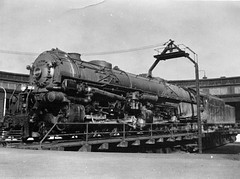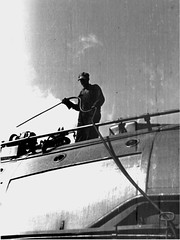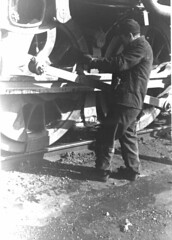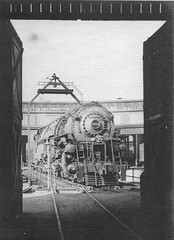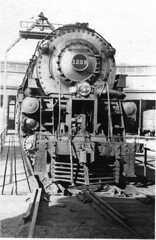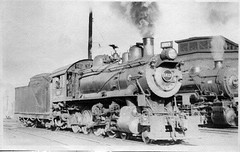Gerard M. Foley
Travel & Photography Collection
An Afternoon at the Norfolk and Western Engineyard and Roundhouse in Columbus, Ohio
One afternoon in 1939 Ralph Ernst, my commercial photographer friend, and I found ourselves in a field some distance from the tracks of the Norfolk and Western engine yard. We were looking at, and probably photographing, this locomotive, number 1209
Mallet's locomotive had the boiler feed the rear engine directly, but the exhaust from the rear engine, rather than being blown up the stack, was fed to the cylinders of the front, articulated engine. Since the exhaust pressure of the back engine was much lower than that of the boiler, the front engine had cylinders of much larger diameter than those of the back one. The exhaust from the front low pressure engine went up the stack to produce the draft for the boiler. A mallet was in the engine yard.
Mallet locomotives had a high tractive force at low speeds, so they could haul heavy trains up heavy grades, but they could not run very fast. When the locomotive speeded up, the exhaust pressure from the small high pressure cylinders dropped too low for the low pressure engine to be effective. From 1915 on there was a gradual introduction of articulated four cylinder locomotives, with all the cylinders fed directly from the boiler and exhausting directly up the stack. The Norfolk and Western, with its heavy coal traffic, continued to use and build Mallet compunds, but they too found a need for large locomotives that would be capable of higher speeds. Number 1209 is one of them.
When Ralph and I first saw it, it was not on a turntable, as above, but standing on a track at the edge of the yard. As we took pictures, a man came across the field from the railroad and said "What would you do if I came into your front yard and started taking pictures of your house without asking permission?" After we introduced outselves, the roundhouse foreman took us back to th engine and set a mechanic to cleaning it for us to photograph it.
A little earlier I had taken a photograph of a Pennsylvania Mountain type locomotive on a turntable, framed by the a roundhouse door. The upper part of the engine had not proved to be silhouetted against the sky above the opposite roof of the roundhouse. When I described this to the N&W foreman, he had 1209 put on the turntable, as you see in the first picture above , and posed it for shots through the roundhouse door.
As you see, the silhouetting didn't work the second time either.
An unusual locomotive was in the engine yard.
Only a few 4-8-0 types have ever been built for American railroads. The Lehigh Valley may have had some around 1880, and some western road may have used the type around 1900. This engine, with its narrow firebox, looks as if it were built about that time. The odd steam pipe from the smokebox to the valve case makes one suspect that it may have been superheated, which would imply rebuilding of the boiler after 1912, when superheating of new locomotives became almost universal, and many old ones were converted to superheating. The Walschaerts valve gear might have been applied at this time. I have no idea why the N&W felt this wheel arrangement was preferable to a large 2-8-0 Consolidation type. A lot of work may have gone into a relatively small locomotive.
When a steam locomotive stood motionless for a time, water would condense in the cylinders. If the engine were run this way, the water might put enough pressure on a cylinder head to blow it off. Steam cocks were placed at each end of the cylinder, and opened (from the cab) when the engine was started, to allow the steam to blow the water out safely. It made an impressive sight. The cocks were closed for running.
